People
‘I Have Always Been in Awe of Nature’: Artist Rebecca Louise Law on the Preciousness and Power of Flowers
The artist tells us about her practice, and explains why she left the floristry industry.
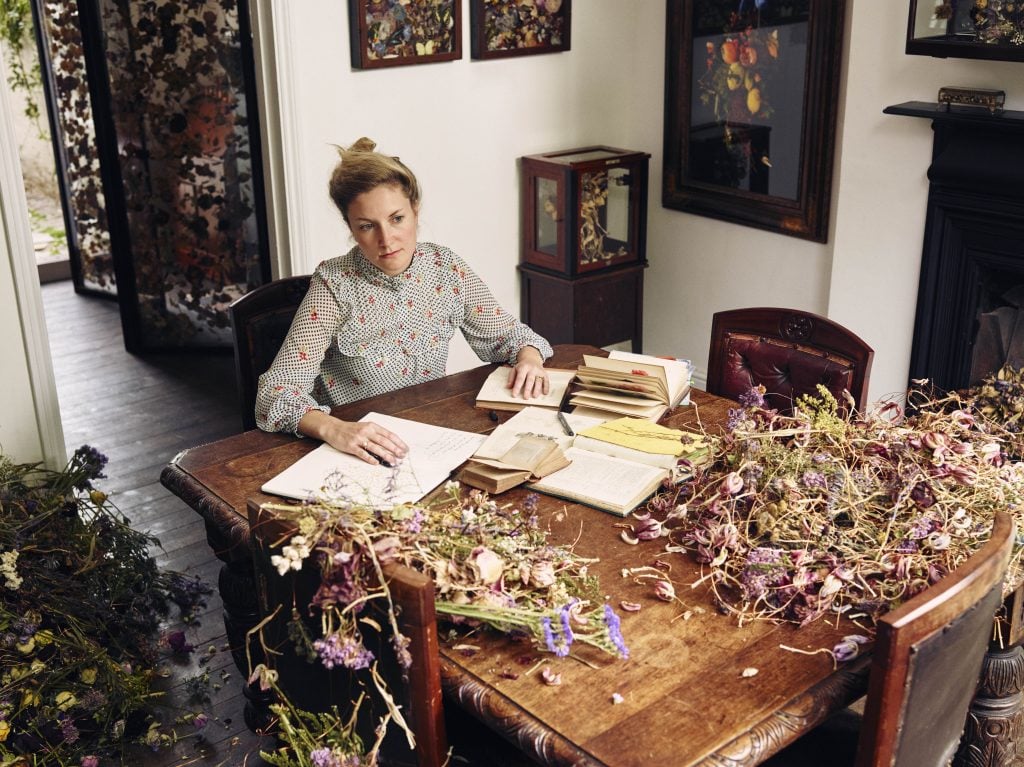
The artist tells us about her practice, and explains why she left the floristry industry.

Maria Vogel

Walking through art exhibitions, it’s easy to get caught in the monotony of what is so often presented: paintings on walls, sculptures on pedestals.
Defying all expectations of what an art exhibition can be, installation artist Rebecca Louise Law has forged a dynamic, multi-sensory practice entirely her own. Law’s medium of choice is flowers, which she employs in seemingly endless formats. Each of her installations is a test to see how far she can push her nontraditional, yet quotidian, medium to create all-encompassing experiences for viewers.
Law embraces her work’s entropy, as it moves through multiple states of life and decay over the course of an exhibition. A longtime advocate for the value of nature and its utmost importance, Law intends for her viewers to slow down and take in their surroundings—and she hopes her audience will do so long after leaving her exhibitions.
We spoke with the artist about her work, how she learned about flowers, and why community is essential in these times.
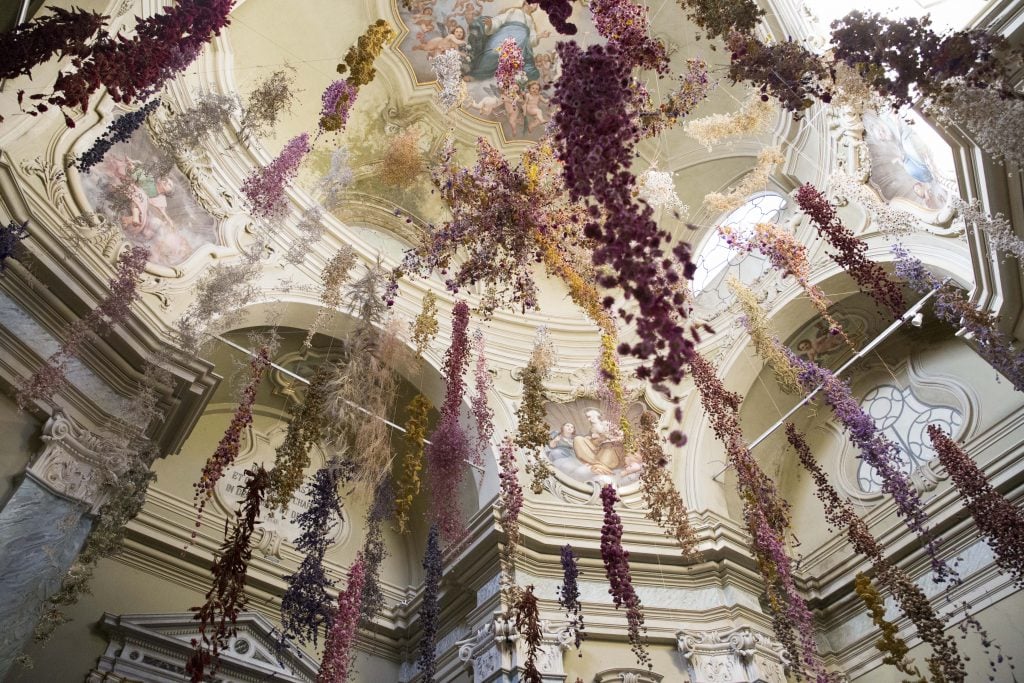
Rebecca Louise Law, Florilegium(2020) in Parma, Italy.
As a classically trained artist, was the decision to work with flowers a difficult one?
While studying fine art, we were encouraged to question boundaries and explore new media. I enrolled as a painter and printmaker, I loved nature and color, and felt inspired by installation art. I wanted my viewer to physically experience nature. After experimenting with many materials for two years, I settled on working with flowers as my medium—my “paint in the air.”
This decision felt challenging and [felt] something that would occupy my mind for life. I remember feeling like I knew nothing. I wanted to find out as much as possible about flowers, the history of flowers, cultivation, industry, and the material property of the flower. To be able to use them with integrity, I had to take myself through a very humbling process of learning.
You have made massive three-dimensional installations of flowers strung from ceilings, as well as works where flowers live in more contained settings. How do you decide what format to work in?
The form of my artworks depends on the space available and the patron. Ideally, I like the artworks to be three dimensional installations, and in as large a space as possible with little interruption. This enables freedom to sculpt and bring the viewer physically into the artwork. The contained and framed pieces are created for longevity, ease of moving, as well [to protect them] from light, insects, and the elements.
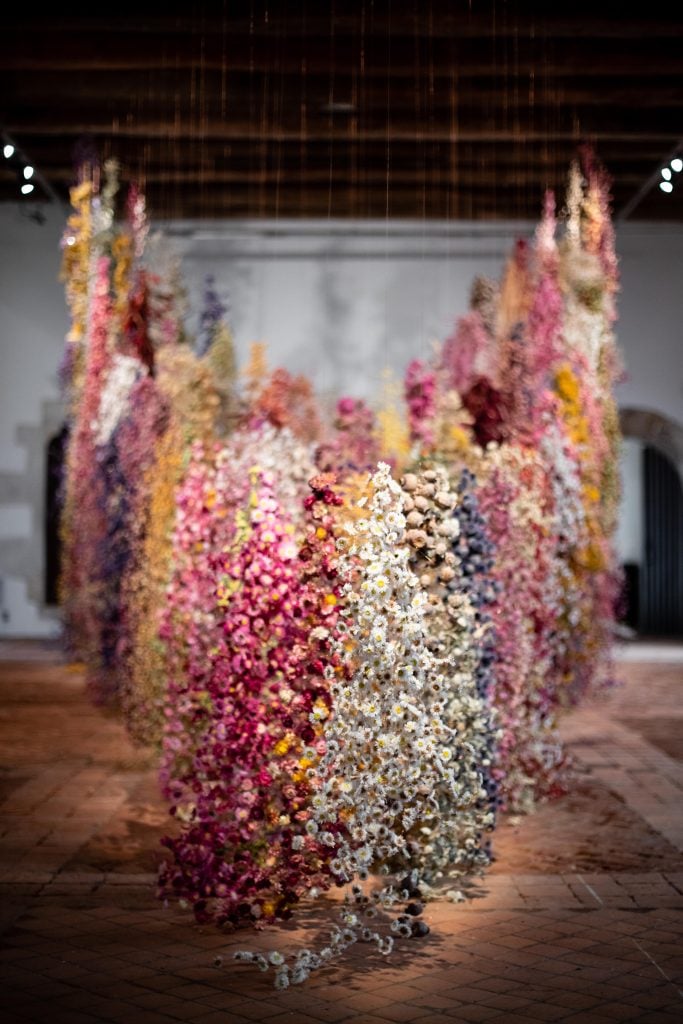
Rebecca Louise Law, Banquet (2019) in La Roche Jagu, France. Photo © Julien Mota.
I’ve approached my art practice as a painter using installation art; the more traditional domestic methods of display remain present in my practice. Using the flowers as my paint and the space as my canvas, the need to create more manageable artworks for domestic environments has always ran alongside my installation art. The painter has never left me, and the safety of the vitrine or frame remains.
When you first set out to create floral installations, was it an easy sell, or did it take time for the work to be considered by galleries and institutions?
When I look back, the process of recognition was fast. But whilst I was living it, it felt slow. I hated having to work to survive and there were at least five years of working as a florist to survive while I struggled to maintain my art practice in any spare second.
While I had no gallery representing me, I used the street or the countryside. I would create installations anywhere I could, with land art and street art popping up wherever I went. I begged and borrowed waste flowers from florists and repainted over old canvases. I would not let finances stop me. However, after a while I decided, I had to work full-time on my art and take the risk. Amazingly, within a year, I had my first large commission.
Have you always had a close bond with the natural world?
Yes, from as young as I can remember, my safe space was in nature. A field, a tree, the sea, a mountain, a river…. I have always felt at peace in nature. My parents also helped to encourage this, with always pointing out the wonders of the earth and educating with any knowledge they knew. I think I have always been in awe of nature, fascinated by its ever-changing cycles.
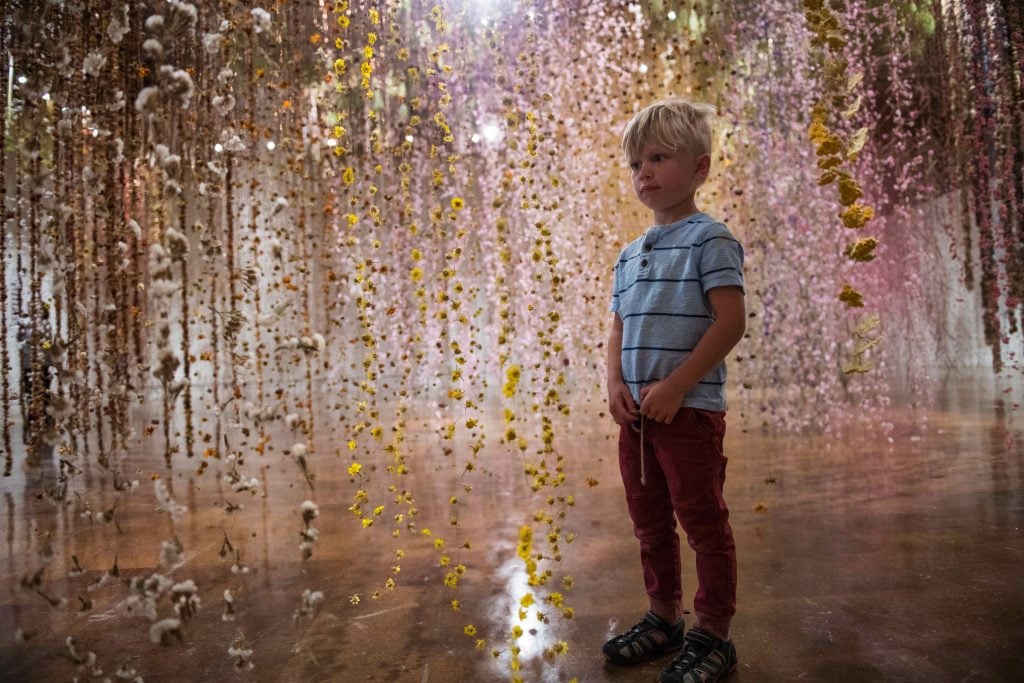
Rebecca Louise Law, Community (2019) at the Toledo Museum of Art.
You have a vast collection of flowers from which you pull from for exhibitions, often reusing and repurposing flowers that have had prior lives in an effort to minimize waste. Do you see your work as a statement of environmental protection?
I pressed the dahlias in my first installation in 2003, and I still have some today. The flower is valuable to me. When I was a child, I watched my grandmother, mother, and aunt collect natural materials and make art out of them. I never saw dead natural material as waste. I think this is why I always struggled in floristry, with thousands of flowers being thrown out daily. I despaired.
However, I have no problem with allowing nature to take its course in the cycle of life and an industry born out of the celebration of life is important. The flowers I preserve, take time to preserve, and I treasure every one of them. Even when they eventually turn to dust, too small to sculpt, I collect them and contain them within glass. I have always treasured every flower that has been entrusted to me.
I am concerned with the throw-away culture that is entwined with a lack of care for nature. We need to take time to value what we have in the micro and macro. I was recently asked if dried flowers were popular now because they are better for the environment. Sadly, I think fashion plays a part, but I think it would be incredible if we each started growing our own flowers, either from window boxes or gardens. Once you put time into cultivation, you start to value the gift of a single flower.
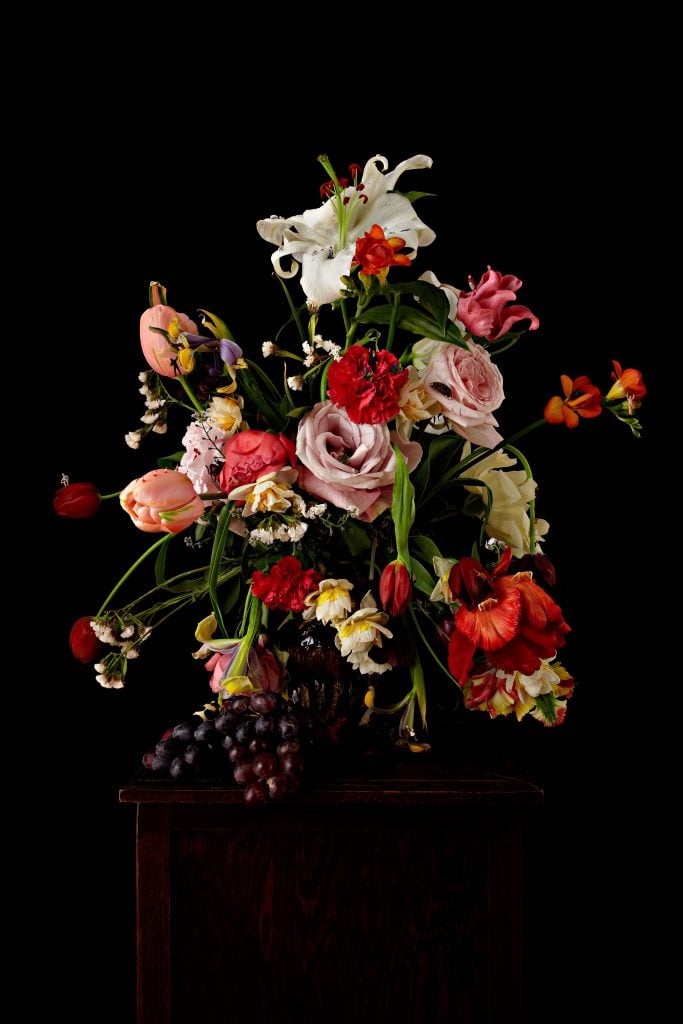
Rebecca Louise Law in collaboration with Tom Hartford, Ambrosius Bosschaert the Elder (2014).
In the time since you’ve been an artist, the world has suffered tremendous loss due to climate change and faces extraordinary obstacles ahead. How does this reality of ever-increasing uncertainty play into your work? Have you found yourself responding to the crisis of climate change through your work?
Personally, I felt an extreme sadness this year. I had a meeting at Kew Gardens with an environmental scientist. I was there to discuss long-term food shortage, but my main objective was to find some kind of hope that we could fix what had already been done to the world. As the meeting drew to a close, I had a pain in my chest and an agony for the earth, the realization of ‘What have we done?!’ and a sense of shame in humanity.
The environmental scientist concentrated on telling me what we can do to adapt to a hotter world in which habitats we need to concentrate on saving. I suppose in my naivety I thought that if we each did a little, we could get there, but the responsibility really does lay on the shoulders of the decision-makers. Unless governments work together internationally to stop greed in industry and consumerism, we are going to lose our beautiful natural world.
It felt utterly frustrating. I believe in the protests and I believe in the petitions. Individually, we can look at the way we live, slow down, and be more conscious of what we spend our money on. We also need to open our eyes to social issues, if someone is struggling to live then they may not care about the earth. Helping a neighbor and knowing your neighbor is vital, we will never move forwards if we have zero communication with each other. It is time to be a community.
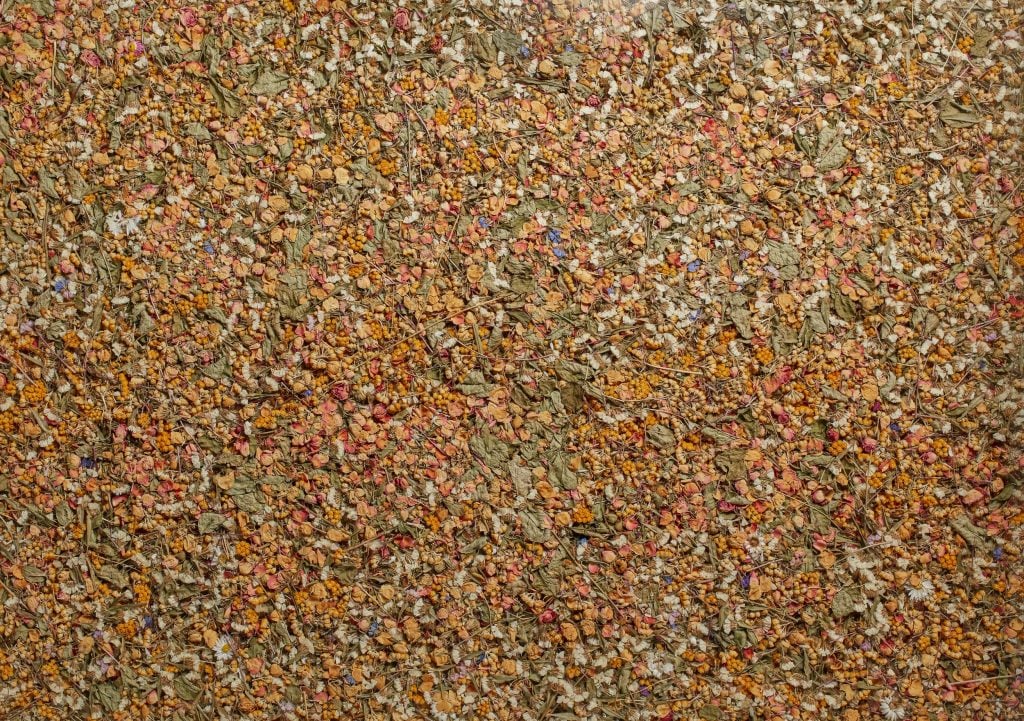
Rebecca Louise Law, Number 1 ‘Dust’ (2018).
How do you continuously challenge your practice?
The material itself is an ongoing challenge. To preserve flora is not easy. I am also working with an incredibly expensive material and this year I grew my first crop of flowers. I hope to continue growing my own and eventually be completely self-sufficient. Conceptually, my exploration of the relationship we have with nature continues, when I first began my practice it was on a euphoric level. Whereas recently I have been delving into the pain entwined with nature. I feel I have still so much more to discover and communicate. The material I have collected over the past 17 years is now over one million elements. This enables me to create much more intricate sculptures and installations, each one a new challenge. I’ve started painting again and using clay and glass to sculpt smaller pieces. I’m really enjoying creating smaller works that sit alongside the installations.
Where do you find yourself returning to in nature to find inspiration?
After a time of sickness in my family we moved from London to Snowdonia in Wales. We adopted a beautiful garden, surrounded by the mountains, sea, and sky. I am inspired daily. My favorite view is the sky and the sea combined, it brings a huge amount of peace to my soul and I am eternally grateful for this space. Simplifying life by observing nature’s extremes, has been incredibly inspirational.